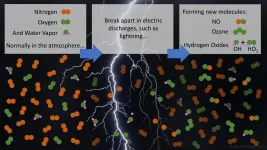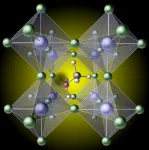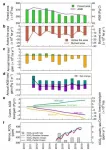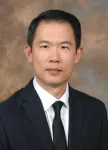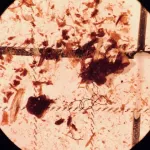(Press-News.org) Lightning bolts break apart nitrogen and oxygen molecules in the atmosphere and create reactive chemicals that affect greenhouse gases. Now, a team of atmospheric chemists and lightning scientists have found that lightning bolts and, surprisingly, subvisible discharges that cannot be seen by cameras or the naked eye produce extreme amounts of the hydroxyl radical -- OH -- and hydroperoxyl radical -- HO2.
The hydroxyl radical is important in the atmosphere because it initiates chemical reactions and breaks down molecules like the greenhouse gas methane. OH is the main driver of many compositional changes in the atmosphere.
"Initially, we looked at these huge OH and HO2 signals found in the clouds and asked, what is wrong with our instrument?" said William H. Brune, distinguished professor of meteorology at Penn State. "We assumed there was noise in the instrument, so we removed the huge signals from the dataset and shelved them for later study."
The data was from an instrument on a plane flown above Colorado and Oklahoma in 2012 looking at the chemical changes that thunderstorms and lightning make to the atmosphere.
But a few years ago, Brune took the data off the shelf, saw that the signals were really hydroxyl and hydroperoxyl, and then worked with a graduate student and research associate to see if these signals could be produced by sparks and subvisible discharges in the laboratory. Then they did a reanalysis of the thunderstrom and lightning dataset.
"With the help of a great undergraduate intern," said Brune, "we were able to link the huge signals seen by our instrument flying through the thunderstorm clouds to the lightning measurements made from the ground."
The researchers report their results online today (April 29) in Science First Release and the Journal of Geophysical Research -- Atmospheres.
Brune notes that airplanes avoid flying through the rapidly rising cores of thunderstorms because it is dangerous, but can sample the anvil, the top portion of the cloud that spreads outward in the direction of the wind. Visible lightning happens in the part of the anvil near the thunderstorm core.
"Through history, people were only interested in lightning bolts because of what they could do on the ground," said Brune. "Now there is increasing interest in the weaker electrical discharges in thunderstorms that lead to lightning bolts."
Most lightning never strikes the ground, and the lightning that stays in the clouds is particularly important for affecting ozone, and important greenhouse gas, in the upper atmosphere. It was known that lightning can split water to form hydroxyl and hydroperoxyl, but this process had never been observed before in thunderstorms.
What confused Brune's team initially was that their instrument recorded high levels of hydroxyl and hydroperoxyl in areas of the cloud where there was no lightning visible from the aircraft or the ground. Experiments in the lab showed that weak electrical current, much less energetic than that of visible lightning, could produce these same components.
While the researchers found hydroxyl and hydroperoxyl in areas with subvisible lightning, they found little evidence of ozone and no evidence of nitric oxide, which requires visible lightning to form. If subvisible lightning occurs routinely, then the hydroxyl and hydroperoxyl these electrical events create need to be included in atmospheric models. Currently, they are not.
According to the researchers, "Lightning-generated OH (hydroxyl) in all storms happening globally can be responsible for a highly uncertain but substantial 2% to 16% of global atmospheric OH oxidation."
"These results are highly uncertain, partly because we do not know how these measurements apply to the rest of the globe," said Brune. "We only flew over Colorado and Oklahoma. Most thunderstorms are in the tropics. The whole structure of high plains storms is different than those in the tropics. Clearly we need more aircraft measurements to reduce this uncertainty."
INFORMATION:
Other researchers at Penn State include Patrick J. McFarland, undergraduate; David O. Miller, doctoral recipient; and Jena M. Jenkins, doctoral candidate, all in meteorology and atmospheric science.
Also working on the project were Eric Bruning, associate professor of atmospheric science, Texas Tech University; Sean Waugh, research meteorologist, and Donald MacGorman, senior research scientist, both at NOAA National Severe Storm Laboratory; Xinrong Ren, physical scientist, NOAA Air Resources Laboratory; Jingqiu Mao, assistant professor of atmospheric chemistry, Univeristy of Alaska; and Jeff Peischl, senior professional research assistant, Cooperative Institute for Research in Environmental Sciences, University of Colorado, Boulder.
The National Science Foundation, NASA, and the National Oceanic and Atmospheric Administration supported this work.
Researchers in the materials department in UC Santa Barbara's College of Engineering have uncovered a major cause of limitations to efficiency in a new generation of solar cells.
Various possible defects in the lattice of what are known as hybrid perovskites had previously been considered as the potential cause of such limitations, but it was assumed that the organic molecules (the components responsible for the "hybrid" moniker) would remain intact. Cutting-edge computations have now revealed that missing hydrogen atoms in these molecules can cause massive efficiency losses. The findings are published in ...
An international team led by Xiangming Xiao, George Lynn Cross Research Professor in the Department of Microbiology and Plant Biology, University of Oklahoma College of Arts and Sciences, published a paper in the April issue of the journal Nature Climate Change that has major implications on forest policies, conservation and management practices in the Brazilian Amazon. Xiao also is director of OU's Center for Earth Observation and Modeling. Yuanwei Qin, a research scientist at the Center for Earth Observation and Modeling, is the lead author of the study.
For the study described in the paper, "Carbon loss ...
As part of a laboratory experiment, Rebecca Holmes examined water bottles that had been acquired from abroad expecting to find bisphenol A (BPA), a human-made component commonly found in polycarbonate plastics used to make consumer products.
What she found, however, was that those water bottles were just fine, yet some control bottles purchased in the United States and supposedly BPA-free actually contained traces of the chemical now thought to negatively impact heart health.
Holmes, a researcher formerly in the laboratory of Hong-Sheng Wang, PhD, professor in the University of Cincinnati Department of Pharmacology and Systems Physiology, was working on her master's degree in molecular, cellular and biochemical ...
WASHINGTON, D.C. (APRIL 29, 2021) - Results from a new study find a broad range of patients who typically undergo revascularization for stable ischemic heart disease (SIHD) in the U.S. did not meet enrollment criteria for the ISCHEMIA trial. The data, which was presented today as late-breaking clinical science at the Society for Cardiovascular Angiography & Interventions (SCAI) 2021 Scientific Sessions, demonstrates a minority of SIHD patients referred for coronary intervention in contemporary practice clearly resemble those enrolled in the ISCHEMIA trial.
Ischemic heart disease impacts more than 13 million people in the United States and is the leading cause ...
WASHINGTON, D.C, (April 29, 2021) - An analysis of growth patterns in transcatheter aortic valve replacement (TAVR) programs across United States hospitals is being presented as late-breaking clinical science at the Society for Cardiovascular Angiography& Interventions (SCAI) 2021 Scientific Sessions. The findings indicate that TAVR hospital programs are predominately located in metropolitan areas serving patients with higher socioeconomic status, potentially contributing to the disparities in cardiac care.
TAVR is a minimally invasive procedure for patients in need of a valve repair or replacement and is an alternative to surgical aortic valve replacement (SAVR), a treatment ...
Washington, D.C., April 29, 2021 - Two studies related to percutaneous coronary intervention (PCI) evaluating the use of risk-avoidance strategies and robotic-assisted technology, respectively, are being presented as late-breaking clinical science at the Society for Cardiovascular Angiography & Interventions (SCAI) 2021 Scientific Sessions. An analysis of strategically avoiding high-risk PCI cases indicates systematic risk-avoidance does not improve, and may worsen, the quality of hospital PCI programs. A study of a robotic-assisted PCI shows the technology is safe and effective for the treatment of both simple and complex lesions; this has the potential to address the occupational ...
The United Kingdom government plans to implement mass scale population testing for SARS-CoV-2 infection using Lateral Flow Devices (LFDs), yet the devices' sensitivity is unknown. A study published in the open access journal PLOS Biology by Alan McNally at University of Birmingham, UK, and colleagues suggests while LFDs are highly effective in identifying SARS-CoV-2 in individuals with high quantities of viral RNA present on the test swab, they are inaccurate at diagnosing infections in individuals with lower viral loads.
LFDs are increasingly used to increase testing capacity and screen asymptomatic populations for SARS-CoV-2 infection in mass surveillance programs, yet there are few data ...
Forget diamonds--plastic is forever. It takes decades, or even centuries, for plastic to break down, and nearly every piece of plastic ever made still exists in some form today. We've known for a while that big pieces of plastic can harm wildlife--think of seabirds stuck in plastic six-pack rings--but in more recent years, scientists have discovered microscopic bits of plastic in the water, soil, and even the atmosphere. To learn how these microplastics have built up over the past century, researchers examined the guts of freshwater fish preserved in museum collections; they found that fish have been swallowing microplastics since the 1950s and that the concentration of microplastics in their guts ...
NASA's Hubble Space Telescope is giving astronomers a rare look at a Jupiter-sized, still-forming planet that is feeding off material surrounding a young star.
"We just don't know very much about how giant planets grow," said Brendan Bowler of the University of Texas at Austin. "This planetary system gives us the first opportunity to witness material falling onto a planet. Our results open up a new area for this research."
Though over 4,000 exoplanets have been cataloged so far, only about 15 have been directly imaged to date by telescopes. And the planets are so far away and small, they are simply dots in the best photos. The team's fresh technique for using Hubble to directly image this planet paves a new route for further exoplanet ...
Boulder, Colo., USA: Thirty-one new articles were published online ahead of
print for Geology in April. Topics include shocked zircon from the
Chicxulub impact crater; the Holocene Sonoran Desert; the architecture of
the Congo Basin; the southern Death Valley fault; missing water from the
Qiangtang Basin; sulfide inclusions in diamonds; how Himalayan collision
stems from subduction; ghost dune hollows; and the history of the Larsen C Ice Shelf. These Geology articles are online at END ...
